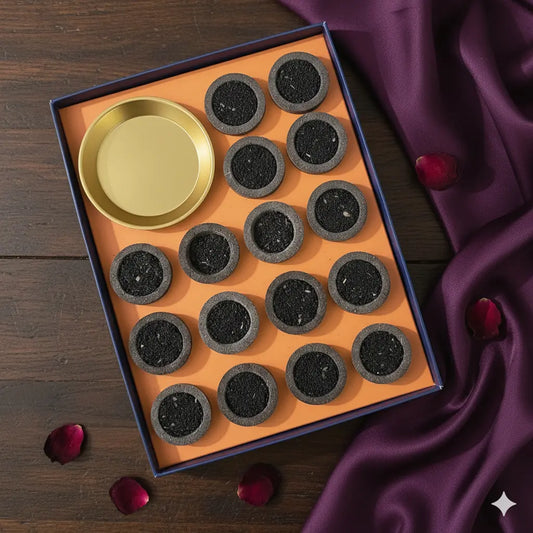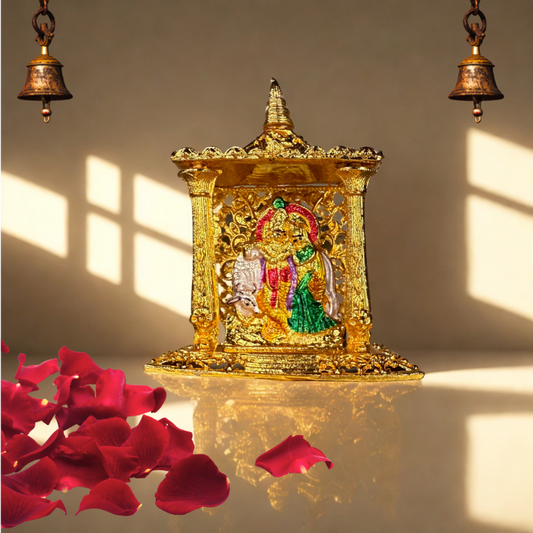
The History and Origin of Incense Cups
Share
Incense has been an integral part of human culture for thousands of years. From temples in ancient India to spiritual practices around the world, incense has carried not only fragrance but also profound symbolism. Among the many forms of incense, the incense cup stands out for its convenience, cultural significance, and spiritual value.
In this blog, we’ll explore the history and origin of incense cups, their role in incense rituals in India, the spiritual and health benefits of incense cups, and how you can integrate them into your daily life with Dharmik’s range of authentic pooja products.

The Ancient Origins of Incense
The tradition of burning incense dates back to prehistoric times when aromatic plants, resins, and herbs were used in fire rituals. Archaeological findings show that incense was used in Egypt, Mesopotamia, China, and India as early as 3000 BCE.
- In ancient Egypt, frankincense and myrrh were offered to deities as a symbol of purification.
- In China, incense sticks were used in Confucian and Buddhist rituals to connect with divine energies.
-
In India, the birthplace of Vedic traditions, incense burning became an inseparable part of spiritual rituals, meditation, and healing practices.
It was in India, particularly during the Vedic age, that incense evolved into a sacred medium for connecting with the divine, cleansing spaces, and creating an atmosphere of tranquillity.
The Evolution of Incense Cups
Originally, incense was used in raw forms such as loose resins, dhoop powders, or sticks. Over time, the incense cup emerged as a more convenient adaptation. These cups are crafted from natural bases such as cow dung, resins, herbs, and essential oils. Their compact design makes them:
- Mess-free compared to powdered incense.
- Long-lasting compared to incense sticks.
-
Safer and cleaner, especially when made without charcoal.
Incense cups thus combine the depth of ancient fragrance with the ease of modern usage. Whether placed in a small mandir at home or used alongside mandir essentials like havan diyas and prasad offerings, they maintain both authenticity and practicality.

Incense Rituals in India
India has always been at the heart of incense culture. The burning of incense is not just an act of fragrance but a ritual of devotion and purification. Some common incense rituals in India include:
-
Temple Worship (Mandir Rituals):
Incense is offered to deities during morning and evening aarti to purify the environment and invite divine blessings. -
Meditation & Yoga:
Sages and practitioners burn incense to enhance concentration, elevate vibrations, and deepen meditation practices. -
Festivals & Celebrations:
Whether during Diwali, Navratri, or Janmashtami, incense is a vital element in pujas and prayers. -
Hawan & Yajnas:
Along with hawan diyas and sacred offerings, incense cups release aromatic smoke believed to ward off negativity. -
Daily Household Rituals:
In Indian homes, incense cups are used in small rituals to purify the air, maintain positivity, and honor family deities.
This deep-rooted tradition is why incense cups are becoming popular again—they combine the essence of ancient incense rituals in India with modern convenience.
Benefits of Incense Cups
The benefits of incense cups go beyond fragrance. Here are some reasons why they are gaining popularity in spiritual and wellness practices:
Spiritual Benefits:
- Creates a sacred aura for prayers and meditation.
- Enhances focus during chanting of mantras with tulsi mala or rudraksha mala.
-
Purifies the environment and removes negative energies.
Health Benefits:
- The herbs and natural resins used in incense cups may have antibacterial properties.
- Certain fragrances like sandalwood and frankincense help reduce stress and anxiety.
- Aromatherapy benefits include improved sleep and mental clarity.
Practical Benefits:
- Long-lasting fragrance without the mess of loose powders.
- Compact design makes them easy to use at home, in temples, or while travelling.
- Safer and cleaner compared to charcoal-based incense
Incense Cups in Modern-Day Living
In today’s fast-paced life, people are turning to incense cups as a way to reconnect with traditions while also enjoying their therapeutic effects. Whether during your morning pooja with mandir essentials, while practicing yoga, or while unwinding after a long day, incense cups bring peace and calmness to any setting.
Many also use incense cups during study sessions, creative work, or before bedtime to relax the mind. They are becoming a sustainable and holistic wellness trend, blending spirituality with mindfulness.

FAQs on Incense Cup
1. What is an incense cup?
An incense cup is a compact, ready-to-use incense form made with natural ingredients like herbs, resins, and essential oils, designed for easy burning and long-lasting fragrance.
2. What are the benefits of incense cups?
They purify the environment, enhance spiritual practices, reduce stress, and promote relaxation while being cleaner and more convenient than traditional incense forms.
3. How are incense cups used in rituals?
They are lit during daily pooja, temple worship, meditation, yoga, hawan, and festive rituals to create a sacred, positive environment.
4. Are incense cups safe for home use?
Yes, incense cups made with natural ingredients are safe. Always place them in a fireproof holder and keep them away from flammable objects.
The history and origin of incense cups are rooted in ancient incense traditions, particularly the incense rituals of India that span across temples, homes, and festivals. Today, incense cups carry forward this legacy in a more practical and modern form, offering countless benefits from spiritual enrichment to health and wellness.
By integrating incense cups into your daily life with Dharmik’s authentic pooja products, you can bring home an experience that connects body, mind, and spirit with divine energy.
👉Shop your mandir essentials here.





